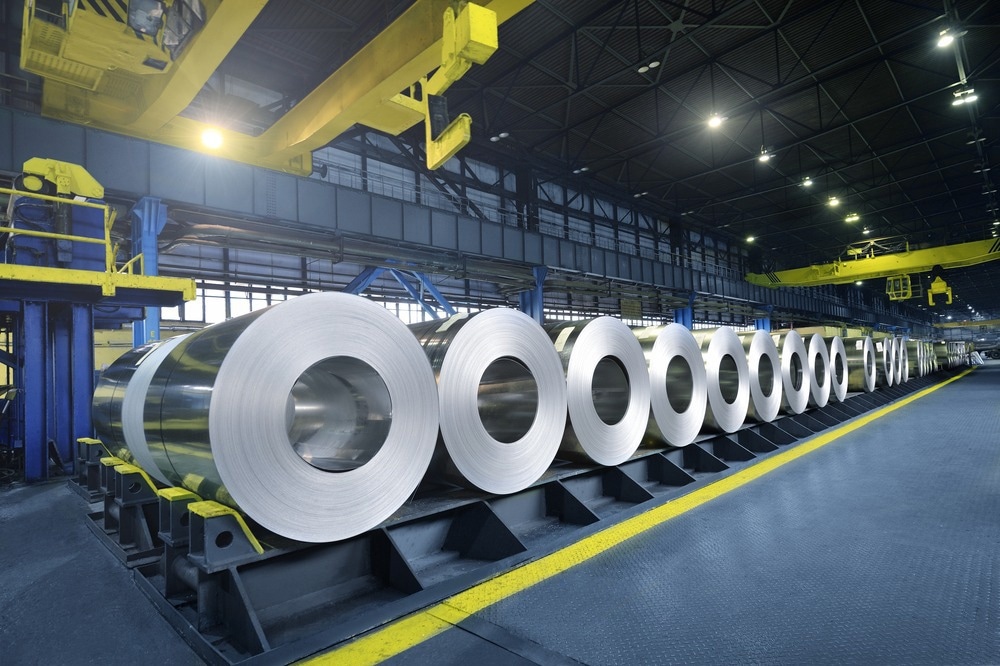Automation and robot technologies have revolutionized the manufacturing sector in recent decades. These innovations have raised productivity, decreased costs, and increased the effectiveness of manufacturing processes.

Image Credit: PhotoStock10/Shutterstock.com
Several sectors, including construction, automotive, aerospace, and electronics, depend heavily on metal sheets. This article discusses the role of automation and robot technologies in metal sheet manufacturing.
Automation and Robots in Metal Sheets Manufacturing
The ability of automation and robot technologies to do repeated activities with excellent precision and consistency is one of its main benefits, contributing to increased metal sheet quality and an enhanced manufacturing process overall. Furthermore, as robots can work around the clock, manufacturing can continue even when employees are not present, resulting in production rise and cost reduction.
Improved Process Speed
In any manufacturing process, speed is of critical importance. Automation and robotics increase production speed by using automated loaders and unloaders that can continually feed a machine without requiring a worker to physically load and remove big pieces of sheet metal. Press tending, pick-and-place tasks, and assembly may all be swiftly and effectively completed by collaborative robots (cobots) without downtime.
Scalability
Scalability is one of the most important advantages of automation and robotics in metal sheet manufacturing. Robotics and automation enable metal sheet producers to scale up or down in response to demand without adding labor, accelerating the transition from the prototype stage to production.
There are a lot of other advantages of robots and sheet metal automation, including enhanced ergonomics and worker safety, improved accuracy, reduced touchpoints on individual parts, cut lead times, consistent cycle times, high-volume output, higher quality products and reduced waste.
Comparing Metal Sheet Manufacturing Processes
Bending Metal Sheets using Automation and Robotics
In the past, hand presses or rollers were used to bend metal sheets, but these laborious methods often produced irregular bends. Automation and robot technologies have made it possible to bend metal sheets using computer numerically controlled machines that can be programmed at certain angles and lengths, producing reliable and accurate bends.
Cutting Metal Sheets
Traditionally, metal sheet cutting was accomplished with manual shears or mechanical saws, which are sluggish and inaccurate and often waste resources. However, with automation and robot technologies, metal sheet cutting is done quickly, precisely, and with reduced material waste by employing lasers, plasma, or waterjets. These techniques can also be programmed to cut intricate forms, which would be difficult or impossible to do manually.
Welding Using Automation and Robot Technologies
As opposed to human handling, automation and robot technologies allow machines to be programmed to weld metal sheets at specific angles and lengths, producing consistent and accurate welds. Robotic welding equipment offers increased safety since it can operate in risky conditions without harming human personnel.
Together with the above processes, automation and robot technologies have enhanced quality control in producing metal sheets. These technologies employ sensors and cameras to identify flaws and irregularities in metal sheets that are difficult or impossible to find manually. This greatly improves the quality of the metal sheets produced and lowers the possibility that consumers would get defective products.
Challenges Associated with Automation and Robot Technologies
There are several limitations to using automation and robot technologies in the production of metal sheets. The initial cost of automation and robot technologies might be substantial, and it could take many years to recover the expenditure is one of the main challenges. In addition, specific manual jobs could become obsolete with automation and robot technology, affecting employment. Yet these technologies also open up new career paths in programming, maintenance, and operations.
Recent Industrial Examples
Leading manufacturers are increasingly investing in automation and robotics-related companies. For instance, Yamaha Motor Ventures recently invested in Machina Labs, which combines robotics and AI to produce innovative sheet metal products.
In addition to developing new alloys, titanium and sheet metal, the investment will be utilized to fulfill customer needs. Machina Labs can produce any imaginable metal part using an inventive mix of dieless sheet metal sheet forming, robots, and AI. The company uses the most recent developments in AI and robots to provide metal sheets quickly and offer clients an extraordinary lead time and competitive edge.
Future Prospects
Given that automation and robot technologies are constantly improving and becoming more effective and efficient, the future of their use in producing metal sheets is bright. As these technologies become more available and inexpensive to a larger variety of organizations, it is anticipated to see even more automation and robots in producing metal sheets in the future, resulting in greater effectiveness, lower labor costs, and quicker production times.
The employment of cobots, which can collaborate with people to carry out activities that need a mix of human judgment and robot accuracy, is one development that is expected to impact the fabrication of metal sheets in the future. Overall, automation and robot technologies have a promising future in producing metal sheets, and more developments in this area are anticipated in the future.
References and Further Reading
Automated Sheet Metal Fabrication and robotics are the future. CADREX Manufacturing Solutions.
Finch, C. (2022). Manufacturing automation: What does it mean for manufacturers? Manufcturing Trends.
Gurjeet Singh, V.K. Banga (2022) Robots and its types for industrial applications. Materials today: Proceedings. Available at:https://www.sciencedirect.com/science/article/pii/S2214785321081682
Machina Labs announces investment from Yamaha Motor Ventures. (2023). Businesswire. Available at: https://www.businesswire.com/news/home/20230215005148/en/Machina-Labs-Announces-Investment-from-Yamaha-Motor-Ventures.
Wilson, M. (2014). Implementation of robot systems: an introduction to robotics, automation, and successful systems integration in manufacturing. Butterworth-Heinemann.
Disclaimer: The views expressed here are those of the author expressed in their private capacity and do not necessarily represent the views of AZoM.com Limited T/A AZoNetwork the owner and operator of this website. This disclaimer forms part of the Terms and conditions of use of this website.